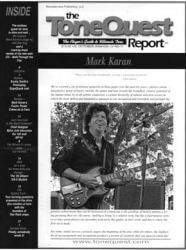
One of the key components in Mark Karan’s live rig is the formidable Mad Professor MP101 amp. As we pondered the true intention of the MP101 and its imposing presence in our music room, it occurred to us that in all the years we have been writing amp reviews and interviews, we had never featured a 100 watt amp that was actually being used on stage by a featured player. Fifty watt versions, yes, and we have tinkered with a vintage 100 watt Marshall or two, but this was a first – a true performance amp with the power to absolutely crush a curious reviewer working in such close proximity to so much air being moved. To protect our ears from the sound pressure created by the MP101, we put up a big Clear-Sonic baffle and let fly over the course of two weeks with stellar results. We also asked the agreeable fellows in Finland at Mad Professor to explain the origins of the MP101 (which we began referring to here as the Magic Pig), and the OS21 prototype we received for review. An informative response from the chief designer of Mad Professor amps, Björn Juhl follows:
I once saw one of my favorite bands play in a stone hall and they had added a second guitarist whose sound was so shrill that I hid between the wooden benches so only the reflection of the sound reached my ears. As a musician and an ardent fan of various guitarists, I have hard all kinds of good and bad guitar tones. I’d think as a musician, one would strive for a sound that gives feedback –both the playable feedback like that which Hendrix mastered,and also the kind of sound that inspires the imagination of the musician. It seems that great sounds travel through generations – from the 15thcentury crumhorn, to the saxophone, and the modern electric guitar. Considering the amount of distorted guitar tones that emanate through speakers worldwide each day in a continuous flow, the distorted electric guitar might have had a larger impact on people than man walking on the moon. As a designer, I primarily work with sounds, studying the composition of distortion, removing unpleasant overtones and applying filtering techniques, while defining the range of the controls so they are intuitive to the user. The biggest inspiration in amplifiers were those that had a sound I didn’t like, because these amplifiers taught me what to avoid and to understand why certain sounds are not pleasing and how to avoid them. I have studied why, for example, on certain amps at full tilt you can only play one note or possibly two at a time and only on the top strings before the amp begins to become muddy and indistinct. I have also studied why E7 on the top strings can, on certain amps, sound out of tune.
The MP101 is inspired partly by feedback we received from users of the Mad Professor Model CS-40 – considerations like two foot-switchable channels, simpler controls, louder output, and a more modern, heavily distorted sound. If the Model CS-40 is a design that gives the musician the tools to sculp this own sound, the MP101 is a design in which the sounds are preset. The best comparison I can think of as far as the inspiration for the sound of the MP-101 is taken from the sound of a perfectly set up VOX AC-30 TB just below where it starts to distort, but with the transient response of a Hi watt or a Marshall Major, or the sound of a 1965 Super Reverb with the volume control set on “6” that a sailor once brought to my shop. Or perhaps the sound of just one Marshall model 1985 set on “6” at the brink of oscillation,where gain would be traded for bandwidth, causing artificial gain, but on the magic spot where distortion is dynamically controllable…. The sound of rock. For channel two, I thought of a high-gain sound with the clarity of definition of an artfully mastered recording.
The design of the MP101 is mostly about creating the feel and the range of sounds within the preamp.The power amp is only allowed to distort for the last inch of power, and since the power amp does not distort abruptly, but more gradually, power levels of near 120 watts can be drawn. Now, considering that such a loud amplifier would rarely be played at full output, what would otherwise be a magic sport in the output of the power